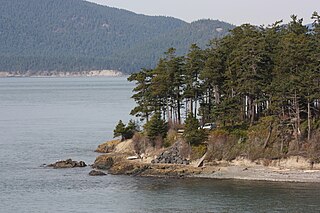
The Douglas fir is an evergreen conifer species in the pine family, Pinaceae. It is native to western North America and is also known as Douglas-fir, Douglas spruce, Oregon pine, and Columbian pine. There are three varieties: coast Douglas-fir, Rocky Mountain Douglas-fir and Mexican Douglas-fir.

Pinus strobiformis, commonly known as southwestern white pine, Mexican white pine or Chihuahua white pine, is a medium-sized white pine tree whose native habitat is in southwestern United States and Mexico. It is typically a high-elevation pine growing mixed with other conifers.

Coulter pine, or big-cone pine, is a native of the coastal mountains of Southern California in the United States and northern Baja California in Mexico. Isolated groves are found as far north as Clearlake, California on the flanks of Mt. Konocti and Black Diamond Mines Regional Preserve. It is named after Thomas Coulter, an Irish botanist and physician. The Coulter pine produces the heaviest cone of any pine tree, up to 5 kg (11 lb) and among conifers is exceeded only by the cones of Araucaria bidwillii.
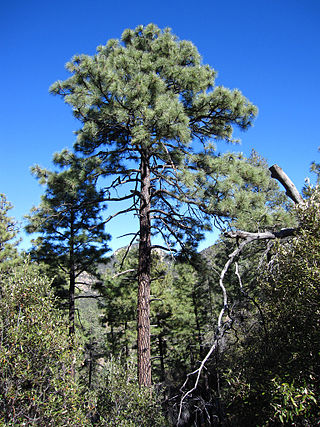
Pinus engelmannii, commonly known as the Apache pine, is a tree of Northern Mexico, in the Sierra Madre Occidental with its range extending a short distance into the United States in southwestern New Mexico and southeastern Arizona. This pine is a medium-sized species with a height of 20–30 metres and a trunk diameter of 35–80 centimetres.

Pinus leiophylla, commonly known as Chihuahua pine, smooth-leaf pine, and yellow pine, is a tree with a range primarily in Mexico, with a small extension into the United States in southeast Arizona and southwest New Mexico. The Mexican range extends along the Sierra Madre Occidental and Sierra Madre del Sur from Chihuahua to Oaxaca, from 29° North Lat. to 17°, between 1600 and 3000 meters altitude. It requires about a rainfall 600 to 1000 mm a year, mostly in summer. It tolerates frosts in winter.

Pinus cembroides, also known as pinyon pine, Mexican pinyon, Mexican nut pine, and Mexican stone pine, is a pine in the pinyon pine group, native to western North America. It grows in areas with low levels of rainfall and its range extends southwards from Arizona, Texas and New Mexico in the United States into Mexico. It typically grows at altitudes between 1,600 and 2,400 metres. It is a small pine growing to about 20 m (66 ft) with a trunk diameter of up to 50 cm (20 in). The seeds are large and form part of the diet of the Mexican jay and Abert's squirrel. They are also collected for human consumption, being the most widely used pine nut in Mexico. This is a common pine with a wide range and the International Union for Conservation of Nature has rated its conservation status as being of "least concern".

Abert's squirrel or the tassel-eared squirrel is a tree squirrel in the genus Sciurus native to the southern Rocky Mountains from the United States to the northern Sierra Madre Occidental of Mexico, with concentrations found in Arizona, New Mexico, and southwestern Colorado. It is closely associated with, and largely confined to, mature ponderosa pine forests. It is named in honor of the American naturalist John James Abert; nine subspecies are recognised. It is recognizable by its tufted ears, gray color, pale underparts and rufous patch on the lower back. The squirrel feeds on the seeds and cones of the Mexican pinyon and the ponderosa pine when they are available, but will also take fungi, buds, bark, and carrion. Breeding normally occurs in summer, with a spherical nest being built high in the canopy.

The Sierra Madre Occidental pine–oak forests are a Temperate broadleaf and mixed forests ecoregion of the Sierra Madre Occidental range from the southwest USA region to the western part of Mexico. They are home to a large number of endemic plants and important habitat for wildlife.

Pinus hartwegii, Hartweg's pine, the Mexican mountain pine, or pino de las alturas, is a pine native to the mountains of Mexico and Central America east to Honduras. It is named after Karl Theodor Hartweg, who described it in 1838.
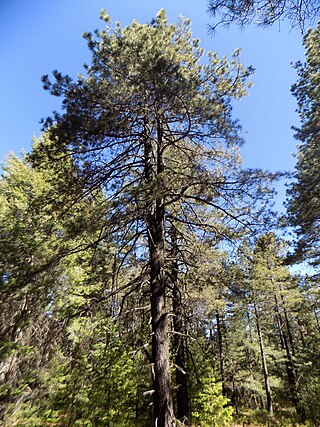
Pinus durangensis, the Durango pine, is a pine tree species endemic to the Sierra Madre Occidental mountain range of north-western Mexico.

Pinus maximartinezii, called Martinez pinyon, big-cone pinyon or maxipiñon, is a pine in the pinyon pine group, native to west-central Mexico.
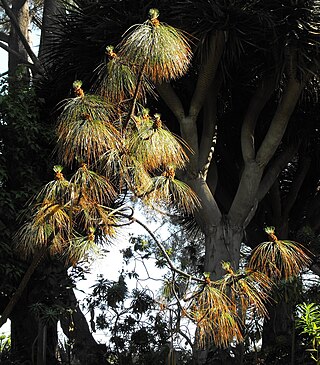
Pinus montezumae, known as the Montezuma pine, is a species of conifer in the family Pinaceae.
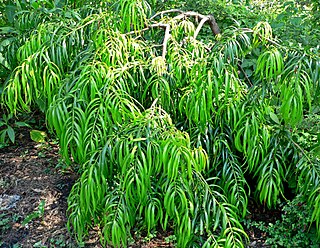
Podocarpus matudae is a species of conifer in the family Podocarpaceae. It is found in Guatemala, El Salvador, Honduras and Mexico.
Quercus macdougallii is a species of plant in the family Fagaceae. It is placed in section Quercus.

Quercus urbani, also known as Quercus urbanii, is a species of oak. It is native to western and central Mexico from Sinaloa, Durango, and Zacatecas to Oaxaca. It was previously synonymized with Quercus pennivenia, but this was restored as an independent species in 2020.

Quercus iltisii is a species of oak tree native to western Mexico, where it is found in a small portion of Jalisco and Colima states.

Quercus durifolia, commonly known as encino colorado, is a species of oak tree native to Mexico.

The Espinazo del Diablo is a region of the Sierra Madre Occidental in the states of Sinaloa and Durango in northwestern Mexico. The region is known its natural beauty and biodiversity, including rare cloud forests, and for a stretch tortuous mountain highway also called the Espinazo del Diablo.
Cornus excelsa is a species of flowering plant in the dogwood genus (Cornus). It is native to mountain forests of Mexico, Guatemala, and Honduras.

Pinus georginae, commonly known as Pino chino, is a species of medium-sized conifer in the family Pinaceae. It was first described by Pérez de la Rosa in 2009, and was named for Georgina Vargas Amado, who was with Pérez de la Rosa at the time of the tree's description. It is in the Pinus subsect. Australes.




















